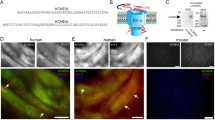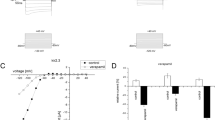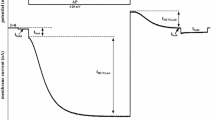Abstract
Voltage-gated K+ channel (Kv) pore-forming (α) subunits of the Kv1 and Kv4 subfamilies have been cloned from heart cDNA libraries, and are thought to play roles in the generation of the transient outward K+ current, I to. Heterologous expression of these subunits in Xenopus oocytes, however, reveals K+ currents that are quite distinct from I to. In the experiments here, the detailed time- and voltage-dependent properties of the currents expressed in mammalian cell lines and in cardiac myocytes by Kv1.4 and Kv4.2 were examined and compared to previous findings in studies of oocytes, as well as to I to characterized in various myocardial cells. As in oocytes, expression of Kv1.4 in HEK-293, Ltk – or neonatal rat ventricular cells reveals rapidly activating K+ currents. In contrast to the currents in oocytes, however, there are two components of inactivation of the Kv1.4-induced currents in mammalian cells, and both components are significantly slower in myocytes than in either HEK-293 or Ltk – cells. In addition, in all three cell types, recovery of Kv1.4 from steady-state inactivation is very slow, proceeding with mean time constants in the range of 6–8 s. The properties of Kv4.2-induced currents also vary with cell type and, importantly, the rates of activation, inactivation and recovery from inactivation are significantly faster in mammalian cells than in Xenopus oocytes. In HEK-293, Chinese hamster ovary (CHO) and neonatal rat ventricular cells, for example, the currents recover from steady-state inactivation with mean (±SD) time constants of 153±32 (n=12), 245±112 (n=10) and 86±38 (n=11) ms, respectively; therefore, recovery proceeds 5–10 times faster than observed for Kv4.2 in oocytes. These results emphasize the importance of the cellular expression environment in efforts to correlate endogenous K+ currents with heterologously expressed K+ channel subunits. In addition, the finding that Kv α subunits produce distinct K+ currents in different cells suggests that cell-type-specific associations with endogenous Kv α or accessory β subunits and/or post-translational processing play roles in determining the properties of functional K+ channels.
Similar content being viewed by others
Author information
Authors and Affiliations
Additional information
Received: 14 August 1998 / Accepted: 19 October 1998
Rights and permissions
About this article
Cite this article
Petersen, K., Nerbonne, J. Expression environment determines K+ current properties: Kv1 and Kv4 α-subunit-induced K+ currents in mammalian cell lines and cardiac myocytes. Pflügers Arch 437, 381–392 (1999). https://doi.org/10.1007/s004240050792
Issue Date:
DOI: https://doi.org/10.1007/s004240050792




